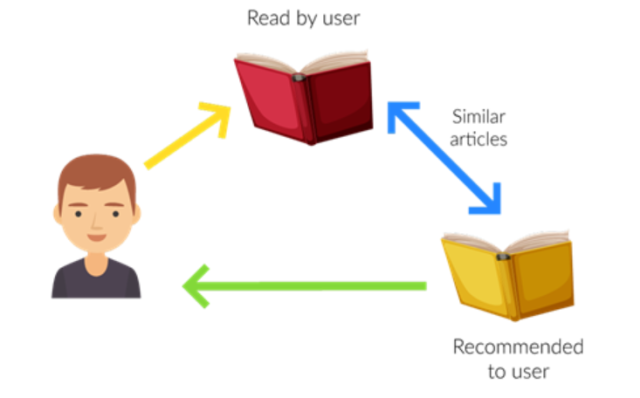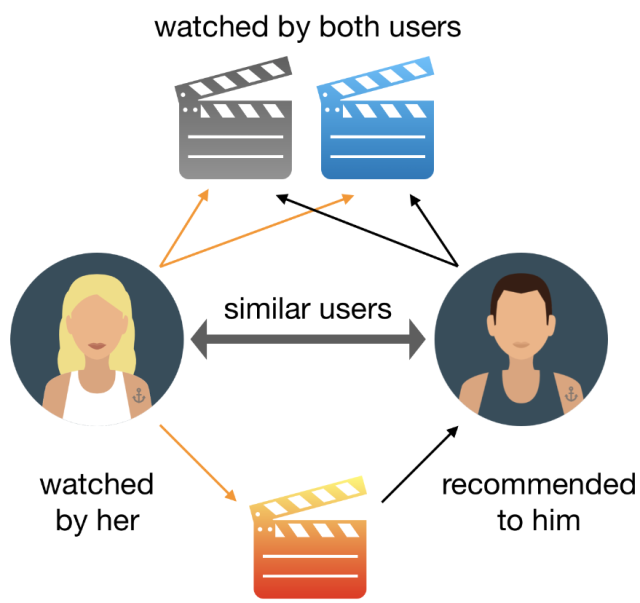- Matrix factorization: Matrix factorization is a dimensionality reduction technique widely used in collaborative filtering-based recommender systems. It aims to decompose the user-item interaction matrix into lower-dimensional representations or latent factors. The idea is to represent users and items in a shared latent space where their preferences and characteristics are captured. This reduces the dimensionality of the original data and allows for efficient computation of recommendations.
- Feature extraction: In content-based filtering approaches, dimensionality reduction techniques can be used to extract meaningful features from item attributes or content. For example, in text-based recommender systems, techniques like Latent Semantic Analysis (LSA) or Latent Dirichlet Allocation (LDA) can be used to reduce the dimensionality of the text data and extract latent topics or features.
The following is a list of benefits / value of building recommender system and why businesses must consider:
- Recommender systems help businesses make money by increasing sales and predicting what customers want.
- Recommender systems can improve customer satisfaction by providing relevant recommendations. They can improve customer loyalty by suggesting new items that the customer may like.
- Recommender systems can reduce the amount of time it takes to find the right item for a customer.
- Recommender systems can help businesses learn more about their customers’ preferences.
Types of Recommender Systems
There are a number of different types of recommender systems. Some of them are listed below:
- Content-based recommendation
- Collaborative filtering based recommendation
- Hybrid recommender system
Content based recommender system
The most common type of recommender system is the content-based recommender system. A content-based recommender system is a type of recommender system that relies on the similarity between items to make recommendations. For example, if you’re looking for a new movie to watch, a content-based recommender system might recommend movies that are similar to ones you’ve watched in the past. The picture below represents content-based filtering recommender system:

Content-based recommender systems are commonly used in music, books, and movies. They can be used to recommend products, services, or even websites. Content-based recommender systems are based on the idea that if you like one item, you’re likely to like other items that are similar to it. To build a content-based recommender system, you need to first define what similarity means. This is where machine learning comes in. A content-based recommender system can use machine learning to learn the similarity between items. Once it has learned the similarity between items, it can make recommendations accordingly.
Collaborative filtering recommender system
Another type of recommender system is the collaborative filtering recommender system. A collaborative filtering recommender system is a type of machine learning algorithm that makes predictions about what a user might want to buy or watch based on the past behavior of other users. The algorithm looks at the items that other users with similar taste have purchased or rated highly, and recommends those items to the new user. The picture below represents collaborative-filtering recommender system:

The main advantage of collaborative filtering is that it doesn’t require any information about the users or items; all it needs is a dataset of past user behavior. Collaborative filtering is one of the most popular techniques for building recommender systems, and is used by major companies such as Amazon, Netflix, and Spotify.
Hybrid recommender system
A third type of recommender system is the hybrid recommender system. The hybrid approach has become increasingly popular in recent years as it offers the potential to overcome some of the limitations of each individual approach.
Content-based recommender systems focus on the attributes of items in order to make recommendations. This can often lead to issues with scalability, as the system needs to be constantly updated with new content in order to make accurate recommendations. Collaborative filtering systems, on the other hand, focus on the relationships between users and items. This can often result in problems with sparsity, as it can be difficult to find enough users who have rated a given item. The hybrid approach seeks to overcome these limitations by combining the two approaches.
A hybrid recommender system is a type of recommender system that combines both content-based and collaborative filtering approaches. The hybrid approach takes advantage of both content-based and collaborative filtering by using them to supplement each other. For example, a hybrid recommender system might first identify a set of items that are similar to the item the user is interested in, and then use collaborative filtering to identify which of those items the user is most likely to enjoy. This approach can provide more accurate recommendations than either method used alone. The hybrid approach has been shown to be more effective than either method used alone, as it is able to leverage the strengths of both approaches. Hybrid recommender systems are often more scalable and efficient than pure content-based or collaborative filtering systems.
Examples of Recommender Systems
Some of the most popular examples of recommender systems include the ones used by Amazon, Netflix, and Spotify.
- Amazon’s recommender system is based on a combination of collaborative filtering and content-based algorithms. It uses past customer behavior to make recommendations for new products. Amazon’s recommender system is one of the most complex and sophisticated in the world.
- Netflix’s recommender system is also based on a combination of collaborative filtering and content-based algorithms. However, Netflix takes things a step further by also incorporating machine learning into its algorithm. This allows Netflix to make predictions about what a user might want to watch based on the behavior of other users.
- Spotify’s recommender system is based on collaborative filtering. It uses past user behavior to make recommendations for new songs to listen to.
Conclusion
Recommender systems are a type of machine learning based systems that are used to predict the ratings or preferences of items for a given user. There are three main types of Recommender Systems: collaborative filtering, content-based, and hybrid. Some of the most popular examples of Recommender Systems include the ones used by Amazon, Netflix, and Spotify. Collaborative filtering systems use past user behavior to make recommendations for new products. Content-based systems focus on the attributes of items in order to make recommendations. The hybrid approach is a combination of both content-based and collaborative filtering approaches. Hybrid recommender systems are often more scalable and efficient than pure content-based or collaborative filtering systems. If you would like to learn more about Recommender Systems, there are many resources available online. Please let us know if you have any questions. Thank you for reading!
I have been recently working in the area of Data analytics including Data Science and Machine Learning / Deep Learning. I am also passionate about different technologies including programming languages such as Java/JEE, Javascript, Python, R, Julia, etc, and technologies such as Blockchain, mobile computing, cloud-native technologies, application security, cloud computing platforms, big data, etc. I would love to connect with you on Linkedin.
Check out my latest book titled as First Principles Thinking: Building winning products using first principles thinking.
- ROC Curve & AUC Explained with Python Examples - September 8, 2024
- Accuracy, Precision, Recall & F1-Score – Python Examples - August 28, 2024
- Logistic Regression in Machine Learning: Python Example - August 26, 2024